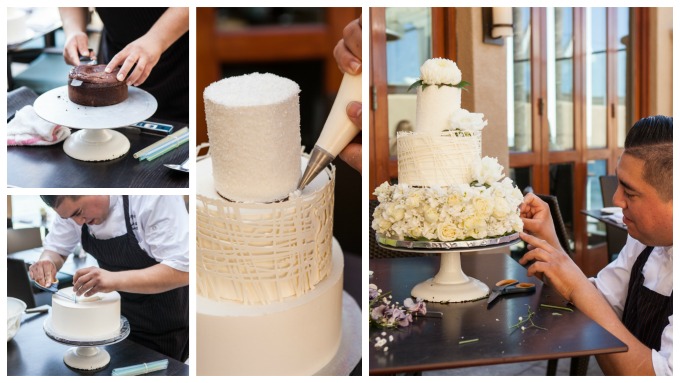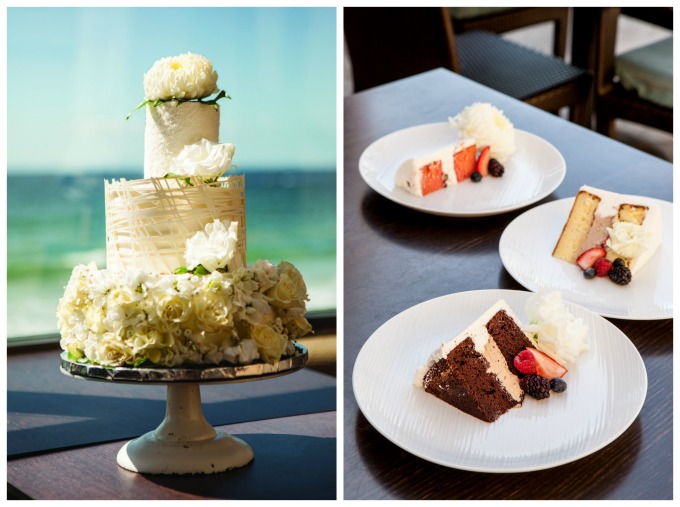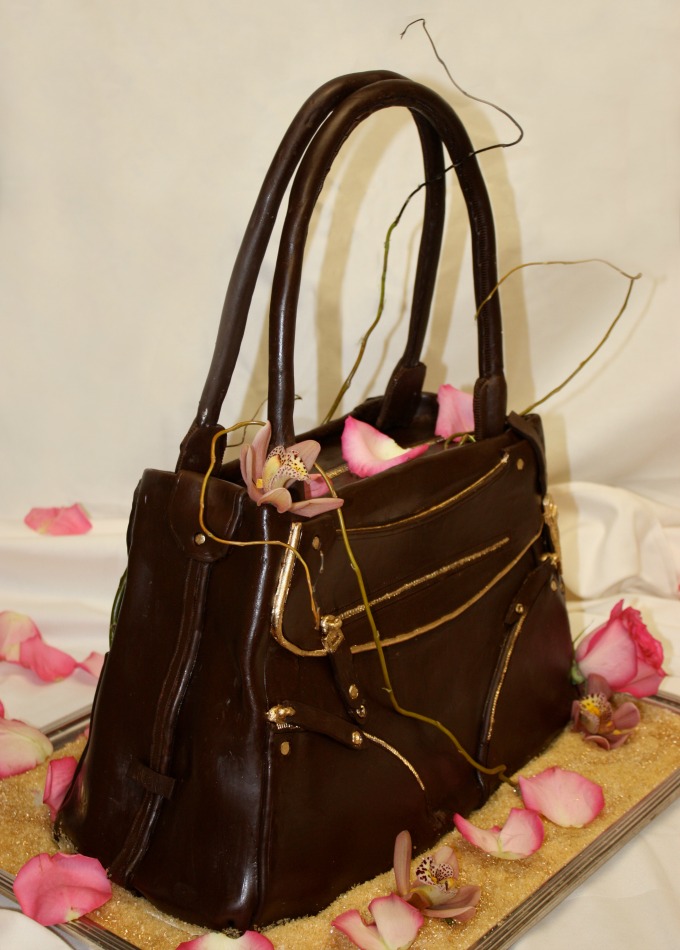
These Laguna Beach pastry chefs create sweet masterpieces for all occasions.
By Cheryl Pruett
When it comes to cakes, beauty is in the eye of the beholder—even before it reaches the taste buds. Whether following the “naked cake” trend or making an elaborate tiered design, it takes more than a spatula to pull off a spectacular work of confectionery art.
Beyond talent, Surf & Sand Resort Pastry Chef Richard Soto emphasizes the importance of another skill required by cake artists: patience. When dealing with elements as delicate as cake and frosting, a slow and steady hand is required, as well as calm under pressure if a towering creation falls over or a piece breaks off and must be redone at the last minute.
Soto isn’t the only one in the Laguna Beach area cooking up elaborate cakes—the art form is nourished by local pastry chefs and cake artists at several luxury hotels, resorts and bakery departments in discerning grocery stores. Some of their sugary sculptures take on fanciful shapes or feature layer upon layer, sometimes with a surprise inside and covered in decadent frosting piped into pretty flowers and swirls. These sweet treats create memorable moments with every bite at birthdays, weddings and other special occasions.
Hidden Talents
At Pavilions grocery store in Boat Canyon Shopping Center, Bakery Manager Sharon Lim oversees the creation of everything from basic sheet cakes to round tiered varieties, while she also makes cakes with fondant in her home kitchen for friends and family. Lim discovered her skills when she enrolled in a fondant cake decorating class at Santiago Canyon College. “I believe [it] does require natural talent to decorate beautiful cakes, as it is a form of creative edible art,” she says. She polishes her techniques by watching YouTube videos and lives by the motto: practice, practice, practice.
With 16 months as a cake artist under her belt, Lim found her most challenging cake was a three-tier red velvet and buttercream wedding cake, created from only a photo and a quick phone call with the client. “It was challenging because I didn’t get to have a consultation with the customer. … But it turned out beautiful,” she says.
The red velvet wedding cake was a far cry from her first cake at age of 6 when she “threw flour, eggs, milk and gummy bears in a bowl” and baked it in a toaster oven. “I didn’t realize sugar was one of the main ingredients,” she says. “It tasted horrible, but my mother ate it and said it was a healthy cake.”
Later, an important lesson involved a common type of icing. “I didn’t realize covering cold cake with fondant would result in the fondant cracking,” she says. This icing sheet literally cracked and fell off the cake. Lim says once she moved past panic mode, she understood the problem, let the cake reach room temperature and was able to finish it in time.
No matter the challenge, Lim’s secret for making impressive decorated cakes is the easiest to replicate at home: Be creative and have fun.

Sweet Engineering
Jamon Harper, meanwhile, approaches cake decorating like an architect. “It’s like building a dream house,” says the executive pastry chef at Monarch Beach Resort, just over the Laguna border in Dana Point. “First you have a vision. … The second stage is the realization of that vision—what materials, colors, et cetera, do you need to create the final look? Most important, however, is the foundation. For instance, a cake that has berries in it will need more focus on stabilizing the foundation. If you start with an uneven or crooked foundation, the end result will be just that.”
Trained at Johnson & Wales University in Providence, R.I., Harper believes cake decorating involves natural talent, but says it takes years of experience and “you are always learning.”
Cake decorating has been one of Harper’s many roles during his 17-year career as a pastry chef. He believes experience in all facets of baking and pastry, as well as a background in architecture—he worked for a firm in Barbados for three years—has aided in his ability to create and re-create cakes.
Harper’s cake baking began under his mom’s tutelage, while his introduction to decorating was with his aunt. “My mom … had the ability to bake cakes without using a scale … with amazing accuracy,” he says, adding that she could tell the weight of ingredients by using just her hand and eye. “… My mom and my aunt were my inspiration for this industry.”
Harper says his most impressive cake was a nine-tier creation for a celebrity golfer in Barbados. If the height wasn’t impressive enough, the cake also had $20,000 worth of roses imported to complete the decoration. Another unusual request was for a wedding proposal cake with a $500,000 engagement ring placed in the center. A guard was assigned to watch the cake in the pastry kitchen overnight and until the proposal occurred, Harper recalls.
His most challenging cake, however, was for a bride who requested the cake take the form of Cole Haan bag. It was “extremely detailed,” he says of the confection.
Yet, Harper sees simplicity, flavor, fresh flowers, glazes and vibrant colors as just a few of the current trends in cake decorating. His secret for amazing cakes is three-prong: simple flavors, straightforward design and sound structure including a strong foundation.
His tools of the trade are a serrated knife and spatula. “I go back to the foundation and structure of the cake,” he says. “My serrated knife and spatula are my two most important tools. Without that foundation, you are dead in the water. Cutting and icing the cake are critical.”
Also crucial is color, he says. “For instance, if I told you about a cake that was matcha-lime with white chocolate-pistachio mousse, then I showed you a cake that was pink, would you be inclined to eat it? If, however, I showed you this cake that had a shiny lime-green glaze and [was] decorated with sliced Sicilian pistachios, then you are more drawn to it.”
Small details are also important. “They can easily redirect your focal point or can be overwhelming,” Harper says. “Gold placed correctly can bring elegance to the cake.” Among his techniques is airbrushing, a popular method, especially when it comes to fondant cakes. “… We would normally finish [it] with a light luster,” Harper says.
In any artistic endeavor, mishaps can occur. Harper recalls one time when the bottom layer of a five-tier cake was not built correctly. “We saw a slight lean and removed and redid it,” he says. “It could have been a disaster.” In the end, artistry won out.

Imaginative Icing
Before eventually landing at Surf & Sand Resort, Soto trained as a pastry chef at the Culinary Institute of America and it was there that he learned the basis for the art of cake making. His experience has taught him that creating a great cake is as much about listening as it is about baking. Listening to your guest’s request—and embracing whatever they have dreamed up—and always striving to make it better than they expected is his goal, including working extra hours to hone the fine details. “I believe it’s never in your best interest to take shortcuts when it comes to decorating cakes,” he says. “Pictures always show imperfections.”
Soto’s secret to an standout cake? It’s the tools: a side icer, spatula, level and, of course, imagination. His 12 years as a pastry chef—including the last three years he’s worked with an extra focus on cakes—has taught him how to meet challenges. “You have to structurally design the cake, for not only appearance, but for travel and storing,” he says. “You have to think about your environments. Anything can go wrong if you’re not three steps ahead.”
Case in point, he had a cake droop “massively” after it sat out following the icing process. Room temperature got the better of the cake as it slid and sagged. “I immediately pulled backup sponge from the freezer to remake the cake,” he says. “I didn’t want to risk trying to [just] fix it. [The] best thing [to do] is … start over and learn from the mistake.”
Playing it safe is not an option. It’s no secret that tiered cakes are the ones that elicit the “wow” response. “Height is always key in desserts,” Soto says. One three-tiered cake stands out in his memory: It was created to mimic the Funfetti-style Birthday Cake at famed eatery Momofuku’s milk bar. “I took the idea of the flavors and transformed it into a massive three-tiered cake for a little girl’s 12th birthday,” he says. His artistic reward was his first thank you card in colored pencil from the birthday girl. “And she also drew a picture of the cake I had made [for] her. Needless to say, it was covered in sprinkles, but it was elegant,” Soto says.
He sees a current trend toward simplicity, specifically in the form of “naked cakes,” which can be unfrosted or minimalistic. “A simple, tiered naked cake with nice flowers always makes for a great showpiece … [for] any party or occasion,” Soto says.
Thanks to working at a coastal resort, many of his cakes feature light pastel colors of greens and blues. Pure white and even gold is a big request here in Laguna, he says. He also loves using gold because it “has a certain elegance,” and real flowers because they “finish a cake” and add “freshness.”
For new approaches, Soto often peruses photos on Instagram and Pinterest. “There are a lot of cool ideas to take [as] inspiration,” he says. And, of course, “feeling out what the guest wants and running with it.” And that leaves a wide-open palette—as big as the imagination.




